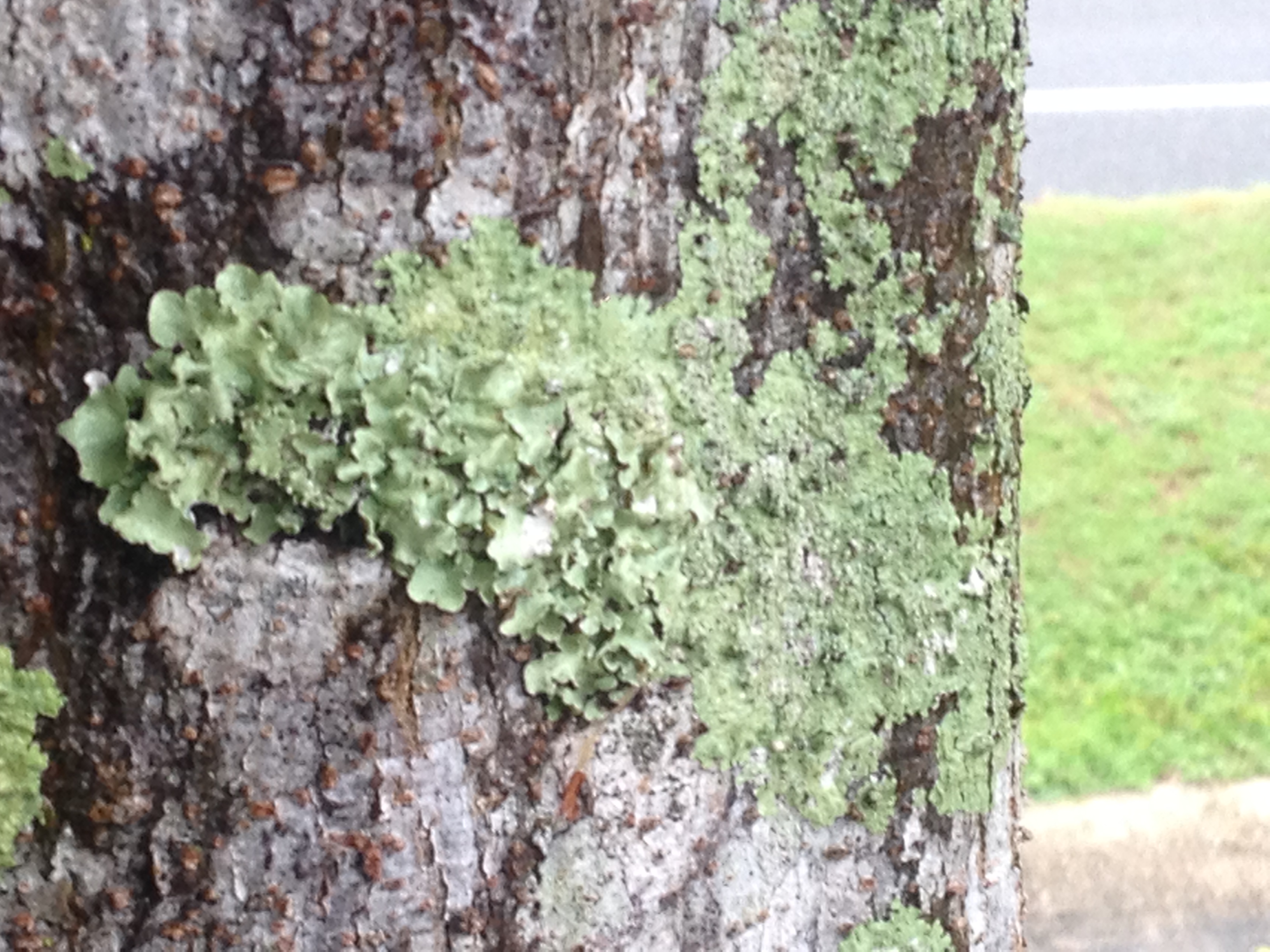
by Eddie Powell | Sep 9, 2014
Throughout the year I get calls asking about this mossy-like stuff growing on the bark of trees. For the most part, the calls are in the spring time when people have come out of winter hibernation and see their landscape plants covered with this alien figure. I am here to say that it is not an alien figure, though it may look like it is. These are lichens.
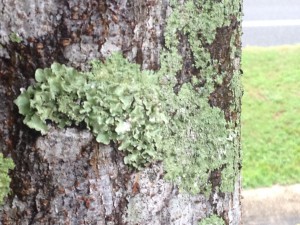
Photo Credit: Eddie Powell
Lichens often get mistaken for some unusual fungus that is killing trees. However, lichens are not single organisms, but rather a combination of two organisms that live together in a mutually beneficial way. There are over 20,000 different types of lichens found in nature. Lichens consist of a fungus and an algae; the fungus is more dependent upon its algae partner which produces enough food for both to survive. Lichens are very different from plants in that they can survive a complete body water loss. During this time, brittle pieces that flake off can later grow into new lichens. When moisture becomes available again, the lichen absorbs water and returns to its fleshy form.
The lichens growing on trees and shrubs are not parasites and do not harm the plants in any way. The lichens use the landscapes as a structure to become established.
There are four different forms of lichens found, crustose (crust-like, growing tight against the substrate), squamulose (tightly clustered and slightly flattened pebble-like units), foliose (leaf like, with flat sheets of tissue not tightly bound), and fruticose (free-standing branching tubes). Colors range from white to gray, green, red, yellow, and black. Lichens commonly found in our area are in the crustose, foliose, or fruticose form, and are white, gray, or gray-green in color.
Because lichens produce chemicals, they have very few natural predators. However, the most serious threat to lichens is air pollution. Most lichens will not grow in a polluted atmosphere and therefore you should be glad to see lichen here or there in your yard, as this is an indication that the air is relatively clean.
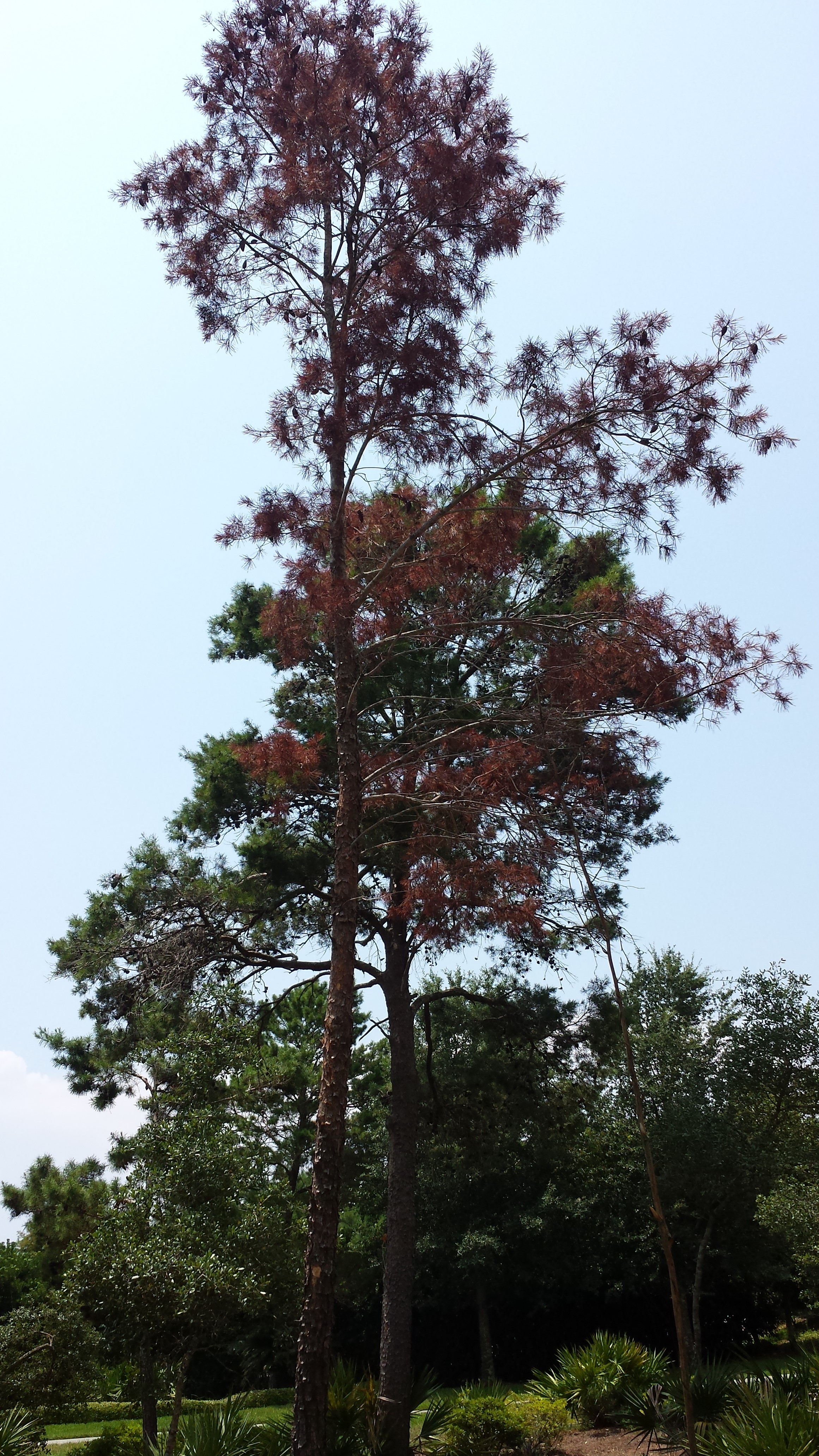
by Sheila Dunning | Aug 19, 2014
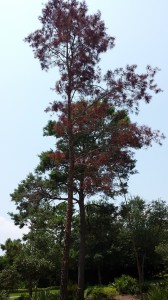 Pine bark beetles are frequent pests of stressed pines in the southern United States. The five most common southern pine bark beetle species include three in the genus Ips. Ips beetles usually colonize only those trees that are already stressed, declining, or fallen due to environmental factors. Infestations may occur in response to drought, root injury, disease, lightning strikes or other stresses including flooding.
Pine bark beetles are frequent pests of stressed pines in the southern United States. The five most common southern pine bark beetle species include three in the genus Ips. Ips beetles usually colonize only those trees that are already stressed, declining, or fallen due to environmental factors. Infestations may occur in response to drought, root injury, disease, lightning strikes or other stresses including flooding.
Ips calligraphus usually attacks the lower portions of stumps, trunks and large limbs greater than 4” in diameter. Early signs of attack include the accumulation of reddish-brown boring dust on the bark, nearby cobwebs or understory foliage. Ips calligraphus can complete their life cycles within 25 days during the summer and can produce eight generations per year in Florida. Newly-emerged adults can fly as far as four miles in their first dispersal to find a new host tree, whichever one is the most stressed.
Most trees are not well adapted to saturated soil conditions. With record rainfall this past April, the ground became inundated with water. When the root environment is dramatically changed by excess moisture, especially during the growing season, a tree’s entire physiology is altered, which may result in the death of the tree.
Water saturated soil reduces the supply of oxygen to tree roots, raises the pH of the soil, and changes the rate of decomposition of organic material; all of which weakens the tree, making it more susceptible to indirect damage from insects and diseases.When the ground becomes completely saturated, a tree’s metabolic processes begin to change very quickly. Photosynthesis is shut down within five hours; the tree is in starvation mode, living on stored starches and unable to make more food. Water moves into and occupies all available pore spaces that once held oxygen. Any remaining oxygen is utilized within three hours. The lack of oxygen prevents the normal decomposition of organic matter which leads to the production and accumulation of toxic gases such as carbon dioxide, methane, hydrogen sulfide and nitrogen oxide. Additionally, within seven days there is a noticeable root growth loss. Roots only develop when soil oxygen levels are at 5% -15%. Over time, the decaying roots are attacked by pathogens. The loss of root mass from decay and fungal attack leaves the tree prone to drought damage. After only two weeks of saturated soil conditions the root crown area can have so many problems that decline and even death are imminent.
When a tree experiences these anaerobic soil conditions it will exhibit symptoms of leaf loss with minimal to no new leaf formation. This usually appears two to eight weeks after the soil dries out again. Many trees will not survive, especially the more juvenile and mature trees. However, well established trees may still decline several years later, if they experience additional stresses such as drought or root disturbance from construction.
There is little that can be done to combat the damage caused by soil saturation. However, it is important to enable the tree to conserve its food supply by resisting pruning and to avoid fertilizing until the following growth season. Removal of mulch will aid in the availability of soil oxygen. Basically, it is a “wait and see” process. While water is essential to the survival of trees, it can also be a detriment when it is excessive, especially for drought tolerant pine species such as Sand Pine, which is prevalent throughout the coastal areas.
For urban and residential landscape trees, preventative strategies to avoid tree stress and therefore reduce the chances of infestation include the following:
1) avoiding compaction of, physical damage to, or pavement over the root zones of pines,
2) providing adequate spacing (15-20ft) between trees,
3) minimizing competing vegetation beneath pines,
4) maintaining proper soil nutrient and pH status and
5) limiting irrigation to established pine areas.
When infested trees are removed, care should be taken to avoid injury to surrounding pines, which could attract the more harmful pine bark beetle species Dendroctonus frontalis, the Southern Pine Bark beetle.
There is no effective way to save an individual tree once it has been successfully colonized by Ips beetles. In some cases, the application of an approved insecticide that coats the entire tree trunk may be warranted to protect high-value landscape trees prior to infestation. UF/IFAS Extension can assist with recommendations.
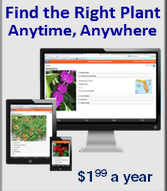
by Mary Salinas | Jul 15, 2014
We all seem to have this dilemma: A desire to re-landscape or just add a few plants to an area, but not knowing what would be the best choice. Plants need to be compatible with their location. The right plant should be chosen for the right place. Many have particular light, moisture and zone requirements in order to do their best. The ultimate size of the plant is also an important consideration; if you want to avoid constant pruning, choose plants that only grow to size you would like to ultimately have. Some great resources are provided below to get you the information you need.
 UF IFAS Extension has a brand new app for your mobile device or web! The app contains a database of over 400 Florida-friendly plants is searchable by plant name, type, shape, native status, light requirements and more. The yearly subscription is only $1.99 to have great info on the go.
UF IFAS Extension has a brand new app for your mobile device or web! The app contains a database of over 400 Florida-friendly plants is searchable by plant name, type, shape, native status, light requirements and more. The yearly subscription is only $1.99 to have great info on the go.
The downloadable 104-page Florida-friendly Landscaping Guide to Landscape Design and Plant Selection not only has photos and detailed information about plants by category, it also has great ideas on how to improve your landscape design! 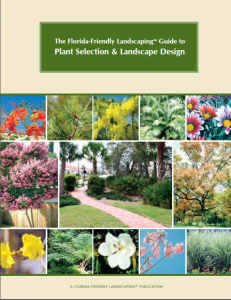
UF’s Florida Yards & Neighborhoods maintains a searchable Florida-friendly Plant Database. Make choices based on region, plant type, light and moisture quantity, soil texture salt tolerance.
For native plants, the Florida Association of Native Nurseries has two websites where you can find plants for your particular zone, plant community (like at the beach or in pine flatwoods), plant type and by wildlife usage. There is a site designed for nursery professionals that lets you find local wholesale growers and also a similar site for homeowners that has resources on where to find desired plants at local nurseries.
Speaking of native plants, the Florida Native Plant Society also has a searchable list of plants appropriate for your particular needs.
Gardening Solutions has lots of great information for lawn, landscape and garden by category, and it is easily accessed.
Happy Gardening!
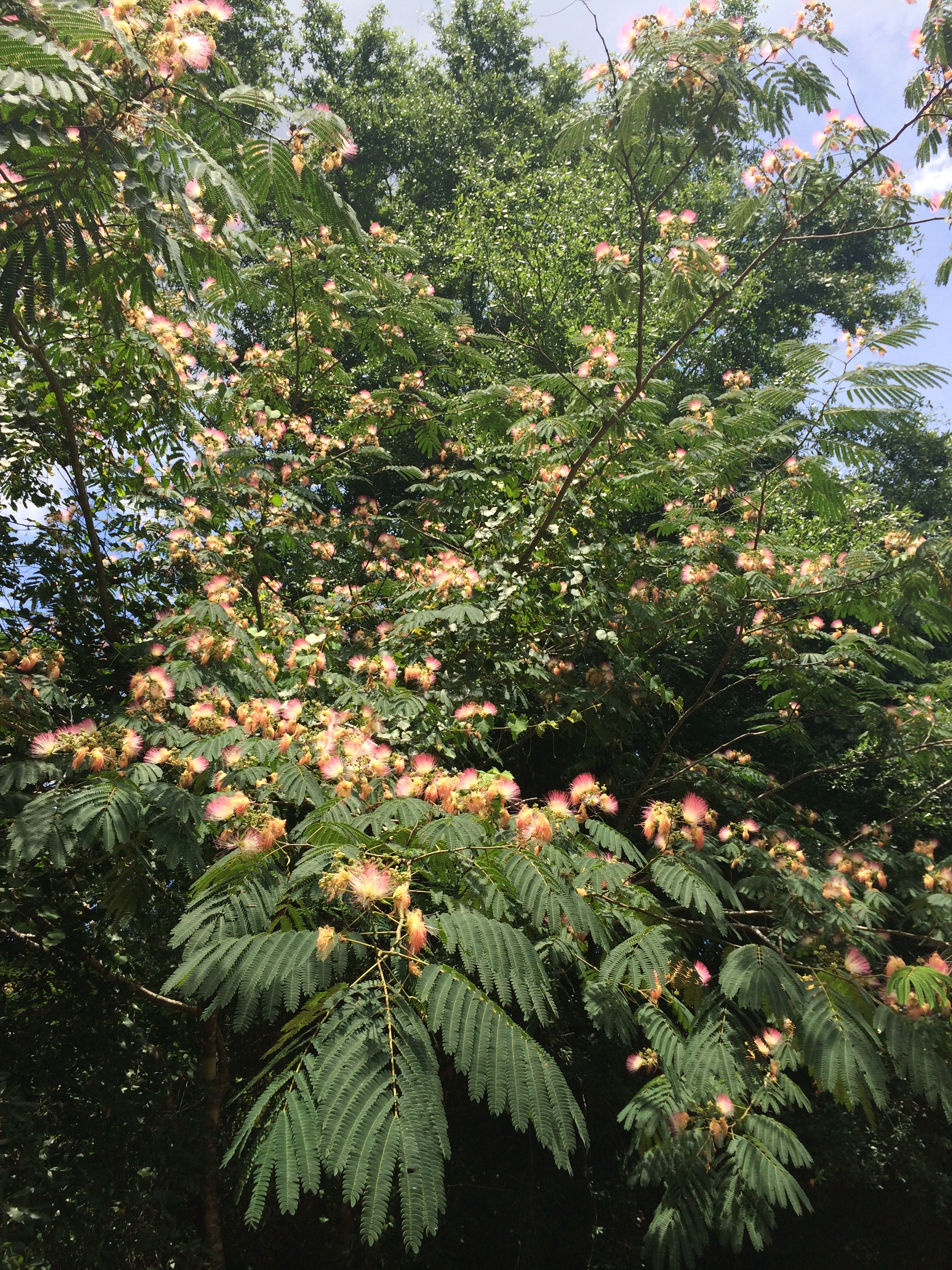
by Mary Salinas | Jun 10, 2014
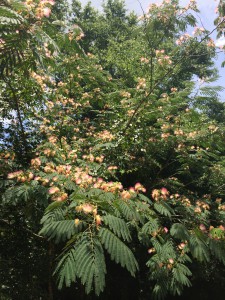
A mimosa tree invader in a natural area. Photo by Mary Derrick, UF IFAS.
All along the roadsides and in home landscapes this time of year, a profusion of fluffy pink blossoms are adorning trees known as Mimosa, or Albizia julibrissin. This native of China was introduced to home landscapes in this country in the 1700’s to enjoy the fragrant, showy flowers and fine, lacy foliage. However, there is a dark side to this lovely tree. After blooming, it produces an abundance of pods each containing 5 to 10 seeds. Seeds can be spread by wildlife and water; this is evidenced by the appearance of mimosa trees along the roadways, streams and in our natural areas. The seeds can also remain dormant for many years, allowing seedlings to keep sprouting up long after the mother tree is gone.
Mimosa has been categorized as an invasive exotic plant in Florida as it has not only naturalized, but is expanding on its own in Florida native plant communities. This expansion means that our native plants in natural areas get crowded out by the mimosa as it reproduces so prolifically.
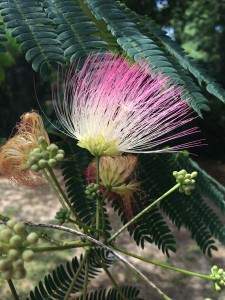
Bloom and foliage of the invasive mimosa tree. Photo by Mary Derrick, UF IFAS.
[important]The Florida Exotic Pest Plant Council (FLEPPC) publishes a list of non-native plants that have been determined to be invasive. Click here for the most recent 2013 list![/important]
The first step in controlling this pest plant is to remove existing plants in the landscape. Cutting it down at soil level and immediately painting the stump with a 25% solution of glyphosate or triclopyr should do the trick. Other details and control methods can be found here.
There are some native trees that make excellent alternatives to Mimosa such as fringe tree (Chionanthus virginicus), silverbell (Halesia carolina) and flowering dogwood (Cornus florida).
For more information:
Albizia julibrissin: Mimosa
UF IFAS Center for Aquatic and Invasive Plants: Mimosa
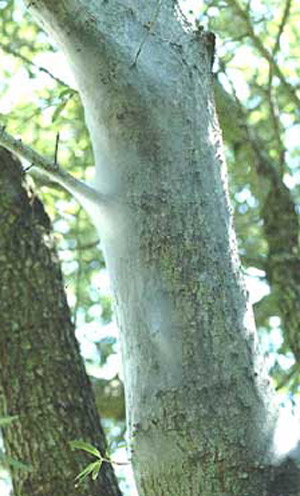
by Larry Williams | Jun 3, 2014
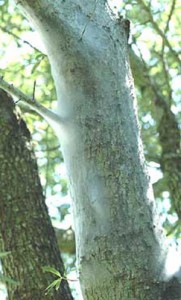
Glistening webbing formed by tree cattle (psocids) Photo credit: Doug Caldwell, University of Florida
Many people are noticing small insects on trunks and branches of their trees. When disturbed, these insects move in a group and are commonly called tree cattle because of this herding habit. They are ¼ inch brownish-black insects with white markings.
Some people assume that these insects will injure their trees but they are harmless. They could be considered beneficial.
These insects are called psocids (pronounced so-cids). They have numerous common names including tree cattle and bark lice. They feed on lichen, moss, algae, fungi, spores, pollen and the remains of other insects found on the tree’s bark. As a result, they are sometimes referred to as bark cleaners.
Tree cattle may form webbing. This webbing is tight against the tree’s trunk and/or limbs. It appears suddenly. The webbing is used as a protection from weather and predators. Underneath you may find psocids.
The glistening webbing may attract a person’s attention resulting in the tree being visually inspected from top to bottom. A dead branch or other imperfections in the tree may be noticed and then wrongly blamed on the tree cattle. I’ve talked to homeowners that sprayed their trees with insecticides or that hired pest control businesses to treat the trees as a result of finding the webbing/psocids. One person told me that he cut down a tree after finding tree cattle. He wrongly assumed that these insects were pests that might move through the area and kill trees. He thought he was doing a good thing.
Adult female psocids lay eggs in clusters on leaves, branches and tree trunks. After hatching, the immature insects (nymphs) remain together under their silk webbing. Adults have wings which are held roof-like over their body. Nymphs are wingless. Psocids usually have several generations per year in Florida.
After seeing the webbing and/or insects, many people insist on spraying insecticides because they believe these insec
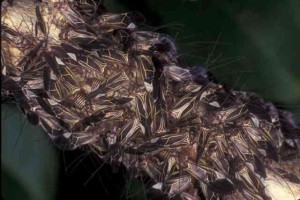
Under the webbing live hundreds of psocids. Photo credit: UF/IFAS Jim Castner
ts are damaging their trees. But as mentioned, they are bark cleaners and do not damage trees. If the silk webbing is considered unsightly, a heavy stream of water from a garden hose can be used to wash insects and webbing off infested trees. If nothing is done, the webbing usually goes away in several weeks.
Psocids can be found on many rough-barked hardwood trees and palms. Occasionally, they may be found on wood siding, fence posts or similar areas.
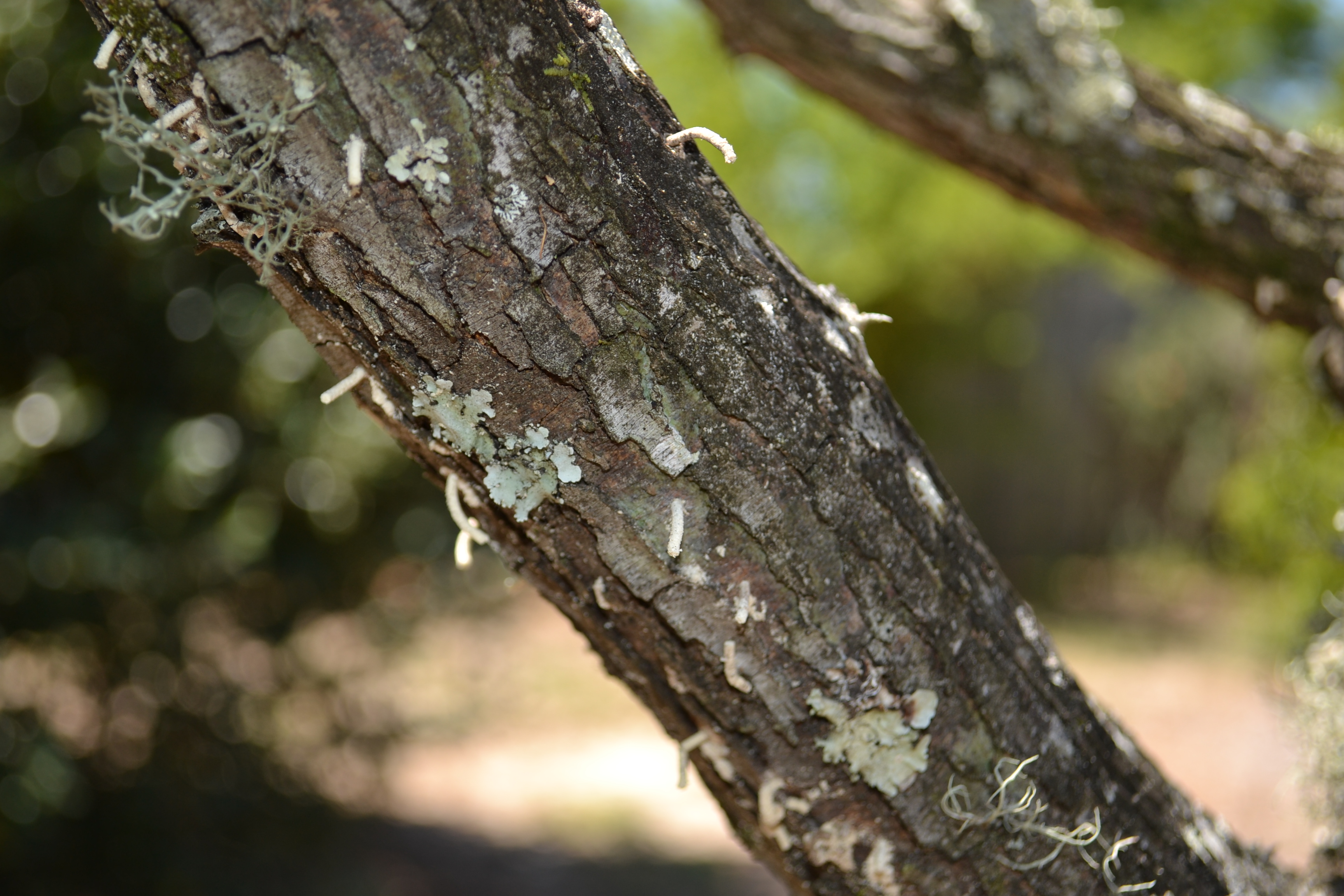
by Beth Bolles | May 27, 2014
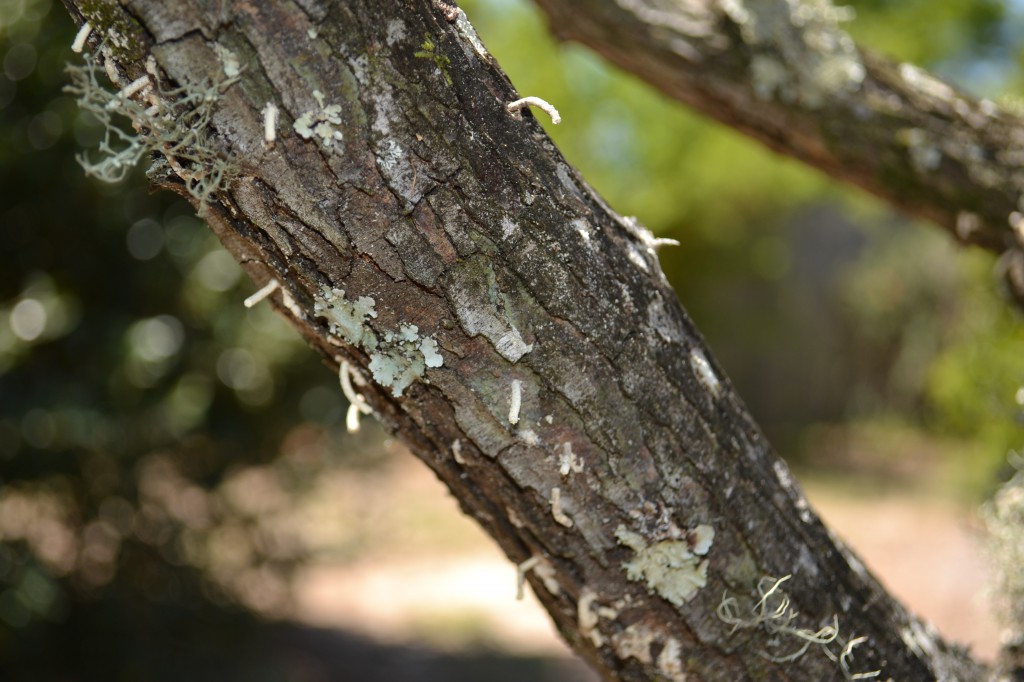
Frass (toothpick-like projections) extends from entry holes on a Jeruselum thorn damaged by cold temperatures. Photo by Beth Bolles, UF IFAS Escambia Extension
Winter injury and stress to many trees has attracted granulate ambrosia beetles to landscapes. These beetles mostly prefer weakened trees and cut stumps/logs but have been found to attack some healthy trees as well.
Adult beetles are very small, only about 1/16 inch long and bore into branches and trunks of many woody plants. They will push out small ‘strings’ of boring dust which look like toothpicks. These strings successfully protect the beetles as they establish galleries for laying eggs and rearing young within the tree. The adult females will introduce a fungus (ambrosia) into these galleries on which both the young beetles and adults feed.
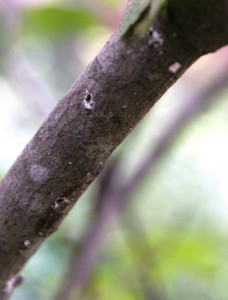
Ambrosia Beetle Entry Point. Photo by Matthew Orwat
Many beetles will bore into a plant, mostly along the trunks. Plants may be ultimately killed, not by the beetles but by the fungi that interfere with the movement of fluids within the tree.
If you notice a tree infested with ambrosia beetles, it is best to remove the plant quickly. Remove all infested plant parts from your landscape. If you have a special plant that you want to save, you may be able to cut it back close to the ground, and allow it to resprout. It would be necessary to monitor the remaining portion carefully for reinfestation and treat with an approved insecticide to prevent beetle entry.
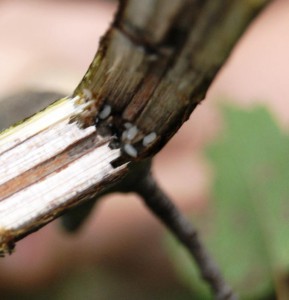
Interior of damaged stem.


















